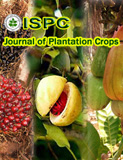Development and characterization of foam mat dried palmyrah fruit pulp powder
DOI:
https://doi.org/10.25081/jpc.2024.v52.i1.9171Abstract
The Palmyra fruit is a good source of vitamin C, carotenoids, minerals, and sugars and the fruit pulp is used to treat skin problems, nausea, vomiting and improves digestion by relieving constipation. Study was conducted to optimize the process parameters for the production of palmyrah fruit pulp powder using foam-mat drying. Palmyrah fruit pulp was foamed by incorporating egg albumin (EA) (0, 5, 10, 15 and 20 %, w/w) and methyl cellulose (MC) (0, 0.25, 0.5, 0.75 and 1 %, w/w) as foaming agents with different pulp concentrations (PC) (8, 10, 12, 14 and16 °Brix) and various whipping times (WT) (1, 2, 3, 4 and 5 min) using response surface methodology with CCRD design. From the results, the optimum conditions achieved after the numerical and graphical optimization for maximum foam expansion and stability were: EA (6.875 g/100 g pulp), MC (0.262 g/100 g pulp), PC (14° Brix), and WT (2 min). The drying time required for foamed palmyrah pulp was lower than non-foamed pulp. The quality attributes of palmyrah fruit pulp powder obtained from the pulp of 14°Brix added with 6.875 % egg albumin and methyl cellulose of 0.262% whipped for 2 min and dried with a foam thickness of 4 mm at a temperature of 60 °C was found to be optimum to produce the foam-mat dried powder.
Downloads
References
Bag, S.K., Srivastav, P.P. and Mishra, H.N. 2009. Optimization of Process Parameters for foaming of bael (Aegle marmelos L.) fruit pulp, Food and Bioprocess Technology (available online, DOI 10.1007/s11947-009-0243-6)
Chakraverty, A. 1997. Theory of grain drying. In: Post harvest technology of cereals, pulses and oilseeds, 3rd edn. Oxford & IBH Publishing Co. Pvt. Ltd, New Delhi, pp 25–63
Falade, K.O., Adeyanju, K.I. and Uzo-Peters, P.I. 2003. Foam-mat drying of cowpea (Vigna unguiculata) using glyceryl monostearate and egg albumin as foaming agents. European Food Research Technology, 217(6), 486–491.
Jansz, E.R., Wickremasekara, N.T. and Sumuduni, K. 2002. Review of the chemistry and biochemistry of seed shoot flour and fruit pulp of the palmyrah palm (Borassus flabellifer L.). J. Natn. Sci. Foundation Sri Lanka, 30: 61-87.
Jaya, S. and Das, H. 2009. Glass transition and sticky point temperatures and stability/ mobility diagram of fruit powders. Food and Bioprocess Technology, 2(1), 89–95.
Jayaraman, K.S. 1993. Some process technologies for the preparation of convenience foods from fruits and vegetables for defence services. Indian Food Indust 12(5):32–40
Jayaraman, K.S., Goverdhanan, T., Sankaran, R., Bhatia, B.S. and Nath, H. 1974. Compressed ready to eat fruited cereals. J Food Sci Technol 11 (3):18f1–185
Kandasamy, P., Varadharaju, N., Kalemullah, S. and Maladhi, D. 2012. Optimization of process parameters for foam-mat drying of papaya pulp. Journal of Food Science and Technology 2012, 51(10), 2526–2534. doi:10.1007/s13197-012-0812-y.
Karim, A.A. and Wai, C.C. 1999. Foam-mat drying of starfruit (Averrhoa carambola L.) puree. Stability and air drying characteristics. Food Chemistry, 64(3), 337–343.
Kurian, A., Thiripuranathar, G. and Paranagama, P.A. 2017. Determination of total phenolic content and antioxidant activity of Borassus flabeliffer linn. fruit pulp collected from several parts of Sri Lanka. International Journal of Pharm Science Research, 8(6), 2701-2705.
Lee, J., Ye, L., Landen, W.O.and Eitenmiller, R.R. 2000. Optimization of an extraction procedure for the quantification of vitamin E in tomato and broccoli using response surface methodology. Journal of Food Composition and Analysis, 13(1), 45–57.
Mangaraj, S. and Singh, K.P. 2009. Optimization of machine parameters for milling of pigeon pea using RSM. Food and Bioprocess Technology, doi:10.1007/s11947-009-0215-x.
Montgomery, D.C. 2001. Design and analysis of experiments (5th ed., pp. 455–492). New York, USA: John Wiley and Sons.
Mithun, K. and Kaleemullah, S. 2019. Optimization of osmotic dewatering process parameters of jackfruit bulb slices. Journal of Pharmacognosy and Phytochemistry, 8(2), 1871-1877.
Narender, R.P.and Pal, D. 2009. The physico-chemical, sensory, and textural properties of misti dahi prepared from reduced fat Buffalo milk. Food and Bioprocess Technology, 2(1), 101–108.
Patel, S. 1996. Development of process technology for production of tomato powder using foam mat drying techniques. PhD Thesis. Department of Agricultural and Food Engineering, Indian Institute of Technology, Kharagpur, India.
Raharitsifa, N., Genovese, D.B. and Ratti, C. 2006. Characterization of apple juice foams for foam-mat drying prepared with egg white protein and methylcellulose. Journal of Food Science, 71(3), E142–E151.
Rajkumar, P., Kailappan, R., Viswanathan, R. and Raghavan, G.S.V. 2007 Drying characteristics of foamed alphonso mango pulp in a continuous type foam mat dryer. Journal of Food Engineering, 79(4), 1452–1459.
Ranganna, S. 2000. Handbook of analysis and quality control for fruit and vegetable products, 6th edn. Tata McGraw-Hill Publishing Co. Ltd, New Delhi.
Sankaralingam, A., Hemalatha, G. and Ali, A.M.1999. A Treatise on Palmyrah. ICAR. All India Coordinate Research Project (palms). Killikalam, Tamilnadu and Central Plantation Crop Research Institute, Kasaragod, Kerala, India.
Sauter, E,A. and Montoure, J.E. 1972. The relationship of lysozyme content of egg white to volume and stability of foams. Journal of Food Science, 37(6), 918–920.
Thuwapanichayanan, R., Somkiat, P. and Somchart, S. 2008. Drying characteristics and quality of banana foam mat. Journal of Food Engineering, 86(4), 573–583.
Published
How to Cite
Issue
Section
Copyright (c) 2024 Journal of Plantation Crops

This work is licensed under a Creative Commons Attribution 4.0 International License.







 .
.